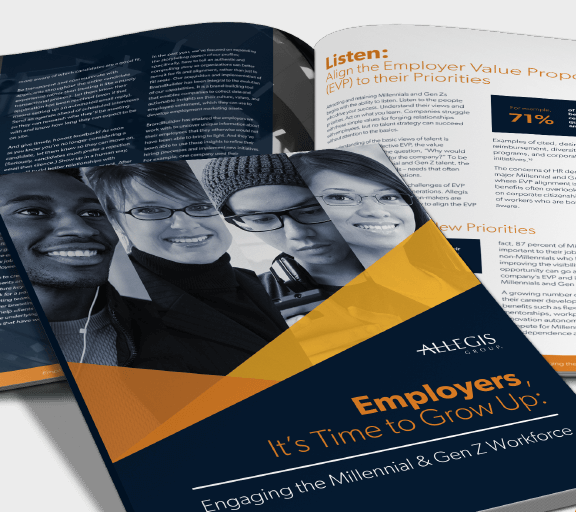Unconscious Bias in the Workplace, What it is & How to Manage it

Humans cannot survive without some of the tendencies that lead to bias. Google estimates that our brains typically process more than 11 million bits of information at a time, yet we can only consciously process 40. How are we handling the other 10,999,960 bits? Some of the information is ignored. Other data is distorted and generalized based on past experience. Unconscious tendencies underlie the myriad actions we take without a second thought (i.e., “In the past, I pressed that button and the elevator door opened, so I will do that now”). The generalized reaction, based on experiences or pre-conceived notions, can lead to unconscious bias.
Unfortunately, the same instinct that enables us to make quick decisions and determinations based on what we think we know also causes us to behave in ways that unfairly affect others. Unconscious bias sneaks into job descriptions and interview questions. It can skew requirements toward male engineers and female nurses. It influences who is involved in a group, who speaks the loudest, who is heard the most, who sits in the back of the room, and who sits up front.
In effect, bias puts an unneeded thumb on the scale as employers weigh the decisions that affect every employee’s experience.
Bias can sneak into every encounter we have and every word we say. It can make coworkers view women who are clear, outspoken, and confident as aggressive while the same qualities in a man earn him praise as being confident. It can make managers overlook performance weaknesses of workers they know and like while noting those weaknesses in the performance of employees they do not know as well. Small, unconscious influences of bias can add up quickly in a company culture with implications for the talent acquisition process, as well as the employee experience.
What is Unconscious Bias?
In the world of talent acquisition, bias has many ways of preventing a connection between a company and the potential new employee. For example, a company may have difficulty finding diverse talent because its sourcing strategies overlook key venues for securing candidates. Consider a campus recruiting effort that targets a university with an under-representation of people from different backgrounds or ethnicity. Could the sourcing effort be expanded to include other universities? If the company understands the deficit and has established goals for improving the candidate slate, those goals will spur talent acquisition to expand campus recruiting.
Bias in talent acquisition also stems from how an organization defines a job vacancy. A diverse candidate may decide not to pursue a job opening because the company builds unconscious barriers into the role’s requirements or descriptions. For example, some military veterans, while not overtly denied access to opportunities, have struggled to align the military language that describes their experience with corporate requirements for a role. Similar issues with biased job requirements leave qualified women and other diverse groups unable to take advantage of opportunities.
Unconscious bias on the part of a hiring manager can also influence candidate evaluation and selection. The prospective candidate, though qualified, may find himself being ignored or rejected at the interview and screening stage. This prejudice on the part of the hiring manager can result in a candidate slate that is skewed toward non-diverse talent, or it can result in diverse talent reaching the interview and evaluation stage and being rejected.
Finally, bias can create a culture for a company that is not inclusive for diverse workers. An employer’s poor reputation as an inclusive place to work will eventually be discovered by prospects, whether through word of mouth, websites like Glassdoor, or other social media venues. As a result, the negative employer brand will drive away prospective talent. With fewer diverse candidates applying and fewer diverse candidates reaching the hiring stage, the supply of diverse talent will dry up for a company that does not manage acceptance and inclusion in its employee culture.
Employee Experience
Bias often stands in the way of an inclusive employee culture, leaving diverse workers to feel unaccepted. Employees who are not accepted are often overlooked. When performance reviews are conducted, a diverse employee may receive more critical scrutiny than her colleagues face. She may be excluded from projects. Diverse employees’ suggestions may fall unheard, or they may be denied raises. Acceptance issues remain a critical symptom of bias in the workplace today, preventing some workers from advancing even when the potential opportunities are present.
At the same time, employees often face unintentional social and physical barriers that act as biases. For many, these issues create personal conflicts and questions, such as, “If I don’t play golf, but my bosses do, will I have access to the conversations, interactions, and deal-making that may help me meet my goals? If I can’t attend a corporate event or physically work in a certain location even though my contribution is recognized as valuable, will I have access to the people, knowledge, and networks I need to advance my career?”
Physical details matter, too. As an example, consider an accessible restroom located on the opposite side of a building from an employee with disabilities who would use it, or a private nursing room that must be shared, scheduled, and used by mothers returning from maternity leave. In each case, the location and availability of the facilities demand that the employee spend otherwise productive time accessing and using such facilities. Thirty extra minutes per day equates to three weeks of working time over a year — a significant disadvantage for an employee who may gain that time back through an adjustment of location or, in the case of the nursing mother, of a policy requiring the use of such a room.
Finally, a company’s policies and practices can be biased against certain employees. Is the employee available or able to attend a leadership development program, or does childcare present scheduling conflicts? Will an employee who works remotely due to a disability be included in discussions that lead to an innovation project group, or will that person be overlooked even though his background and contribution could shape the outcome of the initiative? These are questions that can either lead an
Unconscious Bias in the Workplace
Unconscious bias touches nearly all aspects of diversity in the workforce. Left unchecked, it damages employer reputations, reduces talent acquisition effectiveness, and stands between a company and a significant diverse portion of the workforce. Bias also causes companies to lose diverse workers without achieving full value from them. In other words, bias puts undue pressure on any company’s supply of talent.
D&I programs seek to eliminate or reduce the effects of unconscious bias. Fighting unconscious bias requires commitment and action, but the results, in terms of improved diversity, an inclusive culture, and reduced pressure on the workforce supply, can yield a significant talent advantage for any company that commits to the vision.
Learn more about how to translate a diverse workforce into a business advantage in our report, "Talent, Business, and Competition: A New World of Diversity & Inclusion." Talent and business leaders who download the free white paper will be better prepared to understand the issues, ask the right questions, and consider recruiting and talent management implications.


